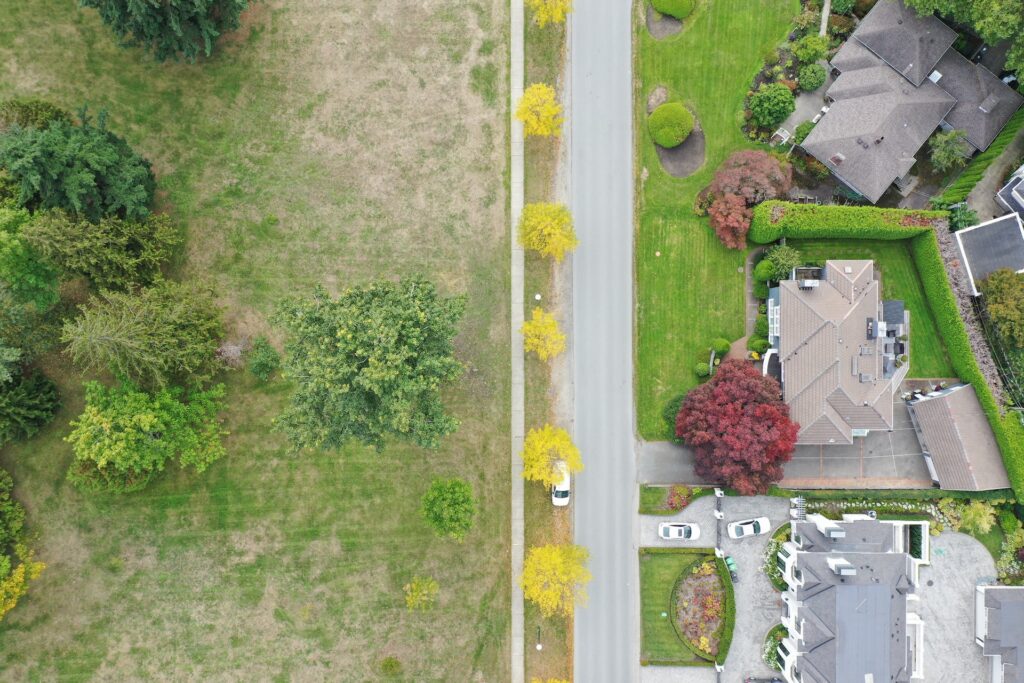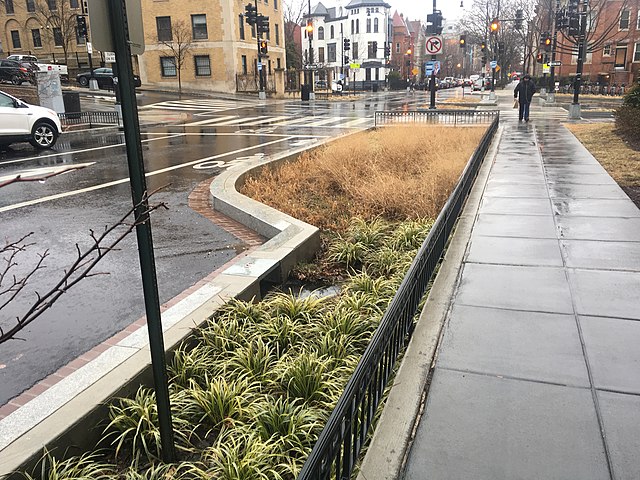Transgression or Restoration? A Critique of Calls for a Transgressive Urban Forest
Sasha Colbert | June 6, 2023

Today’s cities feature highly managed, picturesque scenes of trimmed, tamed and heavily managed nature. Hedged shrubs and trees are confined to strips of greenspace and targeted herbicides stave off unplanned species. Synthetic fertilizers and supplemental irrigation support transplanted species that appear untouched by environmental threats like climate change. The popular “mow and blow” approach to maintenance prevents the buildup of leaves falling from mostly non-fruiting tree varieties, often planted in pastoral scenes with rolling grass hills and isolated groupings of trees.
In the last few decades, a gradual shift has occurred in terms of both aesthetic trends and values attributed to urban nature. Many cities have adopted measures to manage water in the landscape and improve upon the ecosystem services provided by urban greenspaces with strategies such as bioswales, permeable paving, ecological restoration efforts and plants chosen for their fit according to bioregion, microclimate, water consumption, and habitat function. These environmentally conscious trends are informed by theoretical approaches such as Ecological Urbanism, which aims to integrate cities with natural environments. This has brought about new aesthetic trends characterized by meandering paths of decomposed granite, curvilinear forms, and native plants.

A Transgressive Approach?
A 2022 essay in the Journal of the American Planning Association, titled “The Transgressive Urban Forest: An Ecological Aesthetic for the Anthropocene,” warns that these landscape trends communicate a misleading sense of compatibility between cities and nature. Despite recent efforts to improve ecological functioning of urban greenspaces, the authors argue they are often more ornament than ecosystem. The danger of the ecological aesthetic, they claim, is that it has the effect of naturalizing urban environments and anesthetizes city dwellers to the urgency of global environmental concerns. While the article acknowledges advancements in our understanding and design of urban greenspaces and the services they provide, it asserts that urban ecosystems have been degraded to such an extent that their primary function will never be more than aesthetic. Since ecological integrity cannot be achieved, the authors aim instead for intellectual integrity. Rather than a tool for softening urban landscapes, the essay proposes a new, transgressive approach to urban forestry, urging planners to pursue “landscape provocation”, working with landscape architects and urban foresters to create memorable experiences that challenge conceptions of urban nature.
To communicate these provocative messages, the article offers several urban forestry strategies. Ruderal Resurgence, a version of re-wilding, allows for the succession of weeds, shrubs and eventually trees. Plantings that disrupt urban spaces called Forest Shards “create dramatic new tensions, spaces and viewpoints.” Insurgent Trees are described in militaristic terms, “marching” into streets to reclaim territory, planted in unexpected and perhaps inconvenient places. Unkempt Wildness promotes the creation of inhospitable greenspaces that feature dense and over-grown nature, “resistant to human intrusion”. Each of these strategies are meant to challenge the domesticated character of most urban greenspaces and highlight tensions between nature and human settlements.
The critique and strategies offered are compelling. Written for an audience of planners, the essay acknowledges that planners typically do not consider themselves arbiters of taste, yet they play an important role in shaping the visual appearance of landscapes. Valid questions are raised about whether ecological aesthetics give an impression of landscape function that is unwarranted or misleading. The transgressive urban forestry strategies described have the potential to facilitate meaningful and even transformative interactions with urban nature. The strategies of Ruderal Resurgence and Unkempt Wilderness also challenge typical maintenance protocols in ways that could build the ecological capacity of urban green spaces, allowing for the accumulation of biomass and facilitating the regeneration of urban forests. However, some of the underlying assumptions that support their arguments regarding the compatibility between humans and nature and the causes of ecological destruction require deeper consideration.
Ecological Function in Cities
One of the main arguments of this essay is that cities are inherently environmentally destructive. They argue that because ecosystems in urban areas do not have the same level of function held by environments not dominated by human activity, it is misleading to present cities as providing significant ecological roles. While urban developments have undeniably resulted in negative environmental impacts, to paint them as solely destructive disregards the critical roles that cities can play.
Cities are embedded within ecosystems and even a critical component in their functioning. Many of the world’s major cities are in biological hotspots, chosen for many of the unique conditions and resources that attracted other species to settle there. A 2021 article, “The Biological Desert Fallacy” challenges the misconception that cities are devoid of significant ecological activity by illustrating documented positive interactions in urban environments. The essay describes novel urban ecological systems dominated by urbanization-tolerant or synanthropic species (living alongside and benefiting from human beings) and, in some cases, species whose adaptations to urban environments have made them better genetically suited to withstand the effects of climate change. The authors acknowledge the widely documented negative impacts associated with urban development including but not limited to pollution, the spread of invasive species, predation by domestic animals and habitat destruction. However, a growing body of evidence shows that cities can facilitate a range of ecological interactions that are not always harmful.
Some of the positive ecological interactions include providing refuge from threats in the surrounding landscape, increasing regional habitat heterogeneity, such as diverse nesting or feeding opportunities, and stop-over sites for migrating species. While it is useful to take a critical look at the claims of ecological urbanism that may overstate their performance, landscape planners should recognize the persistence of ecosystem function, even in degraded environments, as well as the potential regenerative qualities to strengthen or develop new ecological relationships that were not present prior to settlement.

Impacts, Inequalities & Injustices
Cities also play a key role in concentrating human activities to reduce global environmental impacts. Recent studies have documented that high density development reduces carbon emissions. “Human Settlements, Infrastructure and Spatial Planning”, a chapter from the 2014 report of the International Panel on Climate Change describes the relationship between density and emissions, stating that U.S. households in high density developments have been shown to produce half of the greenhouse gas emissions produced in low density regions. This is due largely to the proximity that high density development creates between residences and places of work, resulting in lower travel distances and more options for more efficient modes of transportation.
The authors’ position about the incompatibility between human settlements and nature presents a dualistic view of humans and nature as inherently separate and opposed. Not only is this the type of rationale that produced the rapid environmental destruction that we see today, but this perspective also suggests that all people have equal accountability for global environmental issues. This lack of nuance obscures the real causes of the global ecological crisis, making meaningful steps towards sustainability harder to identify.
The authors of the “Transgressive Urban Forest” use broad strokes to paint urbanization and city dwellers as the causes of ecological devastation, stating that the current paradigm “deadens city dwellers to their destructive relationship with nature” (407). This assumes all city dwellers are equally responsible for the environmental crisis. The demographic breakdown of greenhouse gas emissions as well as global legacies of environmental injustice complicate this position. Oxfam notes that there are significant inequalities concerning the production of greenhouse gas emissions and vulnerability to their effects. A 2015 study estimated that that the poorest half of the world’s population only produces about 10% of global emissions. These populations are also more likely to live in counties that have suffered the greatest from the impacts of climate change.
Authors Malini Ranganathan and Eve Bratman also illustrate how global environmental concerns such as climate change are linked to settler colonialism and industrial capitalism, stating that these issues “cannot be divorced from harm done unto indigenous bodies and their environments” (P. 2). A tragic example of this is the killing of nearly 5 million bison after the civil war as a method of forcing Native Americans living on U.S. Plains onto reservations, diminishing their capacity for survival and self-determination, as well as the ecological functioning of the plains that had been sustained by their activities. The current ecological crisis that “The Transgressive Urban Forest” attempts to draw attention to arose from these injustices and the disruption of human relationships to the environment, not out of an inherent incompatibility between the two.
A Restorative Approach?
“The Transgressive Urban Forest” offers a useful critique of ecological aesthetics, urging for a more critical look at the functioning of urban ecosystems, and bringing attention to the narratives that urban landscapes both reveal and hide. However, the author’s argument oversimplifies global environmental issues in ways that obscure solutions. It discounts ecological function that differs from pre-settlement conditions, and ignores inequalities and injustices at the foundation of our ecological crisis. The solutions will not come from digging deeper into notions of incompatibility with nature but from efforts to heal and restore the critical positive relationships that exist with nature and with one another.

Sasha Colbert is an MLA student in her third year at California State Polytechnic University, Pomona. Sasha aims to employ her graduate study in landscape architecture, training in fine art, and professional experience in landscape construction to design environmentally and socially regenerative landscapes.